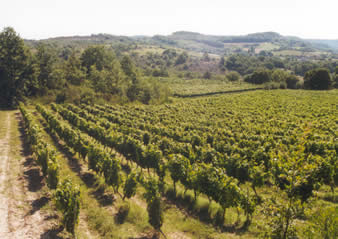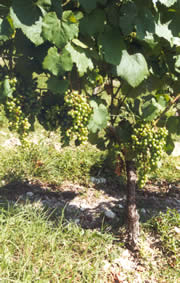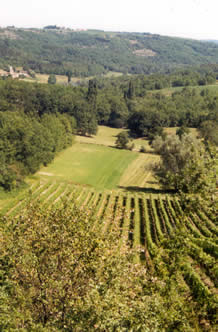
|
The Southwest of France produces a host of interesting yet
poorly known wines. Diversity is the key here. Look at the roll call
of grape varieties: Tannat, Negrette, Auxerrois (or Côt, Malbec),
Mauzac, Fer Servadou are just some of the obscure varieties that have
been planted here since ancient times. This makes it perfect anorak
territory. Perhaps the best known of the southwestern appellations is
Cahors, which has a history dating back to the Roman times. The key
grape here is variously known as Auxerrois, Côt or Malbec, and
legally must represent 70% of the blend – the balance is made up
with Merlot, or less commonly Tannat.
The first thing that struck me visiting the area was that for
an AC region, there’s a surprising lack of vines. Normally, any AC
region would have all the land within the boundaries planted with
vines, but in the relatively green, pastoral Cahors region the parcels
of vineyards are scattered around, and often interplanted with other
crops. You get the impression that despite some external investment in
vineyards here, the region still needs a bit of a boost. Part of the
problem is that the wines are relatively cheap, which is good for the
consumer It’s certainly a pretty region, though, and there’s lots
to hold the attention in the surrounding countryside. My visit was a
fleeting one, but I intend to go back and do a fuller exploration, of
both Cahors itself and also the other southwestern appellations. See: Visit to Domaine du Garinet, Cahors; the wines of Clos Triguedina, Cahors Other wines tasted Clos
Siguier 1999 Cahors Château
Pech de Jammes 1998 Cahors Château Lamartine
Cuvée du Tetre 1999 Cahors Château St Didier
Parnac 2000 Cahors |

 Phylloxera
in the late 19th century, and then a devastating frost in 1956,
decimated the Cahors vineyards, and despite the awarding of the
appellation controllée (AC) in 1971, the region has taken quite some
time to recover. Part of the problem is that Malbec has a tendency to
make wines that are rather tough and charmless in their youth, and
which require ageing. It's not a grape that has been terribly
compliant with the modern thirst for fruity, accessible wines.
However, in recent years, as in so many other French wine regions,
things have begun to change and there are signs of progress.
Phylloxera
in the late 19th century, and then a devastating frost in 1956,
decimated the Cahors vineyards, and despite the awarding of the
appellation controllée (AC) in 1971, the region has taken quite some
time to recover. Part of the problem is that Malbec has a tendency to
make wines that are rather tough and charmless in their youth, and
which require ageing. It's not a grape that has been terribly
compliant with the modern thirst for fruity, accessible wines.
However, in recent years, as in so many other French wine regions,
things have begun to change and there are signs of progress.  but
does act as a bit of a disincentive to vigneron ambition. Let’s hope
that this changes.
but
does act as a bit of a disincentive to vigneron ambition. Let’s hope
that this changes.